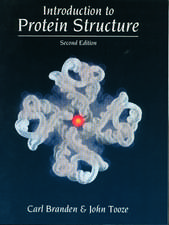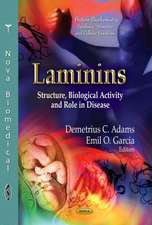Modern Proteomics – Sample Preparation, Analysis and Practical Applications: Advances in Experimental Medicine and Biology, cartea 919
Editat de Hamid Mirzaei, Martin Carrascoen Limba Engleză Hardback – 28 dec 2016
1. The types of samples can be analyzed by mass spectrometry for proteomics analysis.
2. Ways to convert biological or ecological samples to analytes ready for mass spectral analysis.
3. Ways toreduce the complexity of the proteome to achieve better coverage of the constituent proteins. 4. How various mass spectrometers work and different ways they can be used for proteomics analysis
5. The various platforms that are available for proteomics data analysis 6. The various applications of proteomics technologies in biological and medical sciences
This book should appeal to anyone with an interest in proteomics technologies, proteomics related bioinformatics and proteomics data generation and interpretation. With the broad setup and chapters written by experts in the field, there is information that is valuable for students as well as for researchers who are looking for a hands on introduction into the strengths, weaknesses and opportunities of proteomics.
| Toate formatele și edițiile | Preț | Express |
|---|---|---|
| Paperback (1) | 839.74 lei 38-44 zile | |
| Springer International Publishing – 4 mai 2018 | 839.74 lei 38-44 zile | |
| Hardback (1) | 1200.99 lei 38-44 zile | |
| Springer International Publishing – 28 dec 2016 | 1200.99 lei 38-44 zile |
Din seria Advances in Experimental Medicine and Biology
- 9%
 Preț: 719.60 lei
Preț: 719.60 lei - 20%
 Preț: 691.93 lei
Preț: 691.93 lei - 5%
 Preț: 717.00 lei
Preț: 717.00 lei - 5%
 Preț: 716.28 lei
Preț: 716.28 lei - 5%
 Preț: 717.20 lei
Preț: 717.20 lei - 15%
 Preț: 640.24 lei
Preț: 640.24 lei - 5%
 Preț: 1113.83 lei
Preț: 1113.83 lei - 5%
 Preț: 715.71 lei
Preț: 715.71 lei - 5%
 Preț: 820.43 lei
Preț: 820.43 lei - 15%
 Preț: 641.38 lei
Preț: 641.38 lei - 5%
 Preț: 716.28 lei
Preț: 716.28 lei - 5%
 Preț: 523.99 lei
Preț: 523.99 lei - 5%
 Preț: 1031.00 lei
Preț: 1031.00 lei - 5%
 Preț: 717.00 lei
Preț: 717.00 lei - 5%
 Preț: 715.35 lei
Preț: 715.35 lei - 20%
 Preț: 1161.71 lei
Preț: 1161.71 lei - 5%
 Preț: 1170.51 lei
Preț: 1170.51 lei - 18%
 Preț: 1119.87 lei
Preț: 1119.87 lei - 5%
 Preț: 1288.48 lei
Preț: 1288.48 lei - 5%
 Preț: 1164.67 lei
Preț: 1164.67 lei - 5%
 Preț: 1101.73 lei
Preț: 1101.73 lei - 18%
 Preț: 1123.67 lei
Preț: 1123.67 lei - 5%
 Preț: 1435.64 lei
Preț: 1435.64 lei - 20%
 Preț: 1044.10 lei
Preț: 1044.10 lei - 18%
 Preț: 946.39 lei
Preț: 946.39 lei - 5%
 Preț: 292.57 lei
Preț: 292.57 lei - 18%
 Preț: 957.62 lei
Preț: 957.62 lei - 18%
 Preț: 1235.76 lei
Preț: 1235.76 lei - 5%
 Preț: 1231.55 lei
Preț: 1231.55 lei - 5%
 Preț: 1292.30 lei
Preț: 1292.30 lei - 5%
 Preț: 1102.10 lei
Preț: 1102.10 lei - 18%
 Preț: 1132.81 lei
Preț: 1132.81 lei - 5%
 Preț: 1165.19 lei
Preț: 1165.19 lei - 5%
 Preț: 1418.48 lei
Preț: 1418.48 lei - 5%
 Preț: 1305.63 lei
Preț: 1305.63 lei - 18%
 Preț: 1417.72 lei
Preț: 1417.72 lei - 18%
 Preț: 1412.99 lei
Preț: 1412.99 lei - 24%
 Preț: 806.16 lei
Preț: 806.16 lei - 18%
 Preț: 1243.29 lei
Preț: 1243.29 lei - 5%
 Preț: 1429.44 lei
Preț: 1429.44 lei - 5%
 Preț: 1618.70 lei
Preț: 1618.70 lei - 5%
 Preț: 1305.12 lei
Preț: 1305.12 lei - 18%
 Preț: 1124.92 lei
Preț: 1124.92 lei - 5%
 Preț: 1097.54 lei
Preț: 1097.54 lei - 15%
 Preț: 649.87 lei
Preț: 649.87 lei - 5%
 Preț: 1097.54 lei
Preț: 1097.54 lei - 18%
 Preț: 945.79 lei
Preț: 945.79 lei - 5%
 Preț: 1123.16 lei
Preț: 1123.16 lei
Preț: 1200.99 lei
Preț vechi: 1580.25 lei
-24% Nou
Puncte Express: 1801
Preț estimativ în valută:
229.88€ • 249.79$ • 193.23£
229.88€ • 249.79$ • 193.23£
Carte tipărită la comandă
Livrare economică 17-23 aprilie
Preluare comenzi: 021 569.72.76
Specificații
ISBN-13: 9783319414461
ISBN-10: 3319414461
Pagini: 655
Ilustrații: IX, 533 p. 180 illus., 130 illus. in color.
Dimensiuni: 178 x 254 x 33 mm
Greutate: 1.5 kg
Ediția:1st ed. 2016
Editura: Springer International Publishing
Colecția Springer
Seria Advances in Experimental Medicine and Biology
Locul publicării:Cham, Switzerland
ISBN-10: 3319414461
Pagini: 655
Ilustrații: IX, 533 p. 180 illus., 130 illus. in color.
Dimensiuni: 178 x 254 x 33 mm
Greutate: 1.5 kg
Ediția:1st ed. 2016
Editura: Springer International Publishing
Colecția Springer
Seria Advances in Experimental Medicine and Biology
Locul publicării:Cham, Switzerland
Cuprins
Sample Origin.- Sample Preparation for Proteomic Analyses by Mass Spectrometry.- Plant structure and specificity - challenges and sample preparation considerations for proteomics.- Protein Fractionation and Enrichment for Proteomics.- High Performance Liquid Chromatography.- Mass Analyzers.- Top-Down Mass Spectrometry: Proteomics to Proteoforms.- Platforms and pipelines for Proteomics Data Management and Analysis.- Visualization, inspection and interpretation of shotgun proteomics identification results.- Tandem mass spectrum sequencing: an alternative to database search engines in shotgun proteomics.- Protein Inference.- Modification Site Localization in Peptides.- Quantification.- Bioinformatics Tools for the Analysis of Proteomics Data.- Useful Web Resources.- Top-Down Mass Spectrometry: Proteomics to Proteoforms.- Protocol for Standardizing High-to-Moderate Abundance Protein Biomarker Assessments through an MRM-with-Standard-Peptides Quantitative Approach.- Posttranslational Modifications (PTMs) analysis.- Protein-Protein Interaction.- Structural Analysis.- Introduction to Proteomic-Derived Biomarkers.- Discovery of Candidate Biomarkers.- Statistical Approaches to Candidate Biomarker Panel Selection.- Qualification and Verification of biomarker candidates.
Textul de pe ultima copertă
This volume serves as a proteomics reference manual, describing experimental design and execution. The book also shows a large number of examples as to what can be achieved using proteomics techniques. As a relatively young area of scientific research, the breadth and depth of the current state of the art in proteomics might not be obvious to all potential users. There are various books and review articles that cover certain aspects of proteomics but they often lack technical details. Subject specific literature also lacks the broad overviews that are needed to design an experiment in which all steps are compatible and coherent. The objective of this book was to create a proteomics manual to provide scientists who are not experts in the field with an overview of:
1. The types of samples can be analyzed by mass spectrometry for proteomics analysis.
2. Ways to convert biological or ecological samples to analytes ready for mass spectral analysis.
3. Ways toreduce the complexity of the proteome to achieve better coverage of the constituent proteins. 4. How various mass spectrometers work and different ways they can be used for proteomics analysis
5. The various platforms that are available for proteomics data analysis 6. The various applications of proteomics technologies in biological and medical sciences
This book should appeal to anyone with an interest in proteomics technologies, proteomics related bioinformatics and proteomics data generation and interpretation. With the broad setup and chapters written by experts in the field, there is information that is valuable for students as well as for researchers who are looking for a hands on introduction into the strengths, weaknesses and opportunities of proteomics.
1. The types of samples can be analyzed by mass spectrometry for proteomics analysis.
2. Ways to convert biological or ecological samples to analytes ready for mass spectral analysis.
3. Ways toreduce the complexity of the proteome to achieve better coverage of the constituent proteins. 4. How various mass spectrometers work and different ways they can be used for proteomics analysis
5. The various platforms that are available for proteomics data analysis 6. The various applications of proteomics technologies in biological and medical sciences
This book should appeal to anyone with an interest in proteomics technologies, proteomics related bioinformatics and proteomics data generation and interpretation. With the broad setup and chapters written by experts in the field, there is information that is valuable for students as well as for researchers who are looking for a hands on introduction into the strengths, weaknesses and opportunities of proteomics.
Caracteristici
Provides a blueprint for scientists wishing to perform proteomics for the first time Furthers the education for those who have not yet mastered the technique Ties in various aspects of proteomics, including software, instruments, and emerging technologies, to give experienced researchers new insight into the potential applications of proteomics













